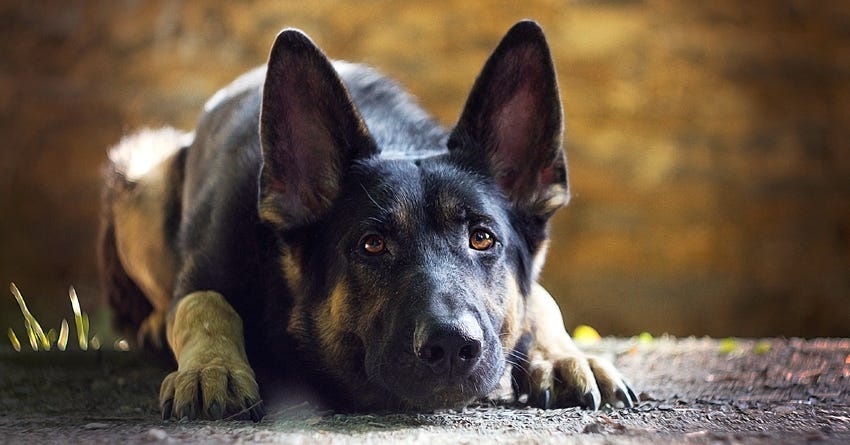Some dogs are naturally super mellow and calm, and some, like my dog, are not.If there’s anything remotely out of the ordinary—a sound off in the distance, a piece of garbage in front of our home, if the tone of my voice changes—he immediately perks up and investigates, hyper alert. Part of it is his protective nature (he’s a German Shepherd), part is that he’s had to deal with chronic itching his whole life—which would make anyone anxious—and part is that he’s just an enthusiastic fellow who wants to be involved.
The long and short of it is, he gets anxious. As a result, he’s gone through quite a bit of training. One of his trainers, Certified Professional Dog Trainer Kate Connell, who runs Calmer Canines, actually specializes in calming dogs down. Out of all his training, her's was the most effective in working Guinness into a less anxious state. Connell offers the following tips to help calm your anxious dog.
 Kate Connell, CPDT-KA, creator and owner of Calmer Canines
Kate Connell, CPDT-KA, creator and owner of Calmer Canines6 Tips to Calm Your Anxious Dog
1. Treats, Treats, and More Treats
Use soft or lickable treats over hard ones because, “chewing, crunching, and chasing bouncing treats is exciting and will amp your dog up instead of calming them down,” she said. Try rehydrated finely ground dog foods, cottage cheese, or plain yogurt in a refillable camping squeeze tube. You can use shredded, baked, or boiled chicken, chopped string cheese, or sausage-like rolled dog foods for treats that need to be dropped on the ground.2. Deep Breaths Help
Deep breathing can be calming for dogs too. Sit or stand in front of your dog in a relaxed posture with treats in your hand but hidden from view behind your back, said Connell. Take a slow, deep breath and blink softly. Wait for your dog to close his mouth and stop panting for even just a brief moment. When he does, say "yes" in a soft voice and calmly bring a treat to his mouth. Continue this until your dog has slowed his breathing. The ultimate goal is for your dog to take deep breaths that cause his nostrils to flare whenever you take a deep breath.3. Have Him Rest His Chin
Place your right hand a few inches in front of your dog just below his chin height, with your palm up and gently curved, and your thumb pointed toward him, said Connell. With treats in your left hand, move it across your right palm so that your dog's nose follows the treats and his chin ends up over your right hand—though he may not be touching your right palm yet. Say "yes" as his chin moves over your palm and give him a treat. Over time, bring your left hand lower so that your dog will press his chin down into your right palm, then say "yes" and offer the treat. Gradually increase how long your dog is expected to hold his chin in place before you say "yes" and give the treat. Increase the time by 1/4- to 1/2-second increments. When he can comfortably hold his chin in place for 2-3 seconds, offer your palm without showing him treats, take a deep breath when he places his chin, then say "yes" and treat. If your dog knows the breathing exercise, he should take a deep breath as well.4. Use "Find It" As a Distraction
You can use sniffing, which is naturally calming for dogs, treats and "find it" to get through some stressful situations. With a handful of treats at the ready, tell your dog to find it and then immediately sprinkle treats on the ground or grass in front of him, said Connell. If your dog is really nervous, he may need some encouragement from you. Try searching through the grass with him, pointing out treats and brushing your hands through the grass, for instance. This will keep him focused on the treat-finding rather than on the stressful or scary situation around him. It will also help him learn to associate the scary thing with something positive—treats. You can also do this one treat at a time while walking past something scary to keep your dog focused on you and the treats, she said. I’ve had particular success using this on my dog when he’s barking at something he hears outside the front door. He’s able to focus all that anxious energy on finding the treats.5. Catch Your Dog Relaxing
This one will require you to pay close attention to your dog. Whenever you catch him in a completely relaxed state—not looking for treats, toys or attention—quietly place a treat right in front of his nose and walk away, said Connell. Don’t praise him or acknowledge him because this will increase the chances of him getting excited and trying to figure out what he did right so that he can replicate the behavior. Your dog’s smart like that. If he gets up after eating the treat, ignore him until he is calm and relaxed again. “The trick is to move like a ninja and catch him in the act of being calm as often as possible, also called ‘capturing calmness,’” said Connell.6. Make His Mat a Refuge
Turn a towel or mat into a safe place for your anxious dog. You’ll need a towel or mat that is new to your dog, and treats of course. Sprinkle some treats on the mat to get him interested in it and just as he is finishing off those treats, give a release cue like "free dog" and encourage him to step off of the mat, said Connell. Wait calmly until your dog shows interest in the mat again, say "yes," and drop a couple of treats on the mat. Say "free dog" and encourage him to step off the mat before he decides to walk away. Continue this game and you’ll want to gradually increase your expectations along the way so that your dog will sniff the mat, then touch it with one paw, two paws, three paws, stand with all four paws on the mat, sit on the mat and finally lie down on the mat. You will not tell your dog to do these things, only say "yes" and reward him with treats when he does them on his own.
At first you’ll want to hide the mat when you aren’t training so that it’s a special treat. After a couple of weeks, you can leave it out and drop a treat or two on the mat for your dog to discover often. When you find your dog relaxing on the mat on his own, you can either quietly treat him, or you can cuddle with him for a bit. Your dog will eventually enjoy lying down on his mat. “Mats can be an island of calm in a sea of chaos because only good things happen there,” said Connell. Trust me, Connell’s training tips work. Try them out on your anxious dog.


